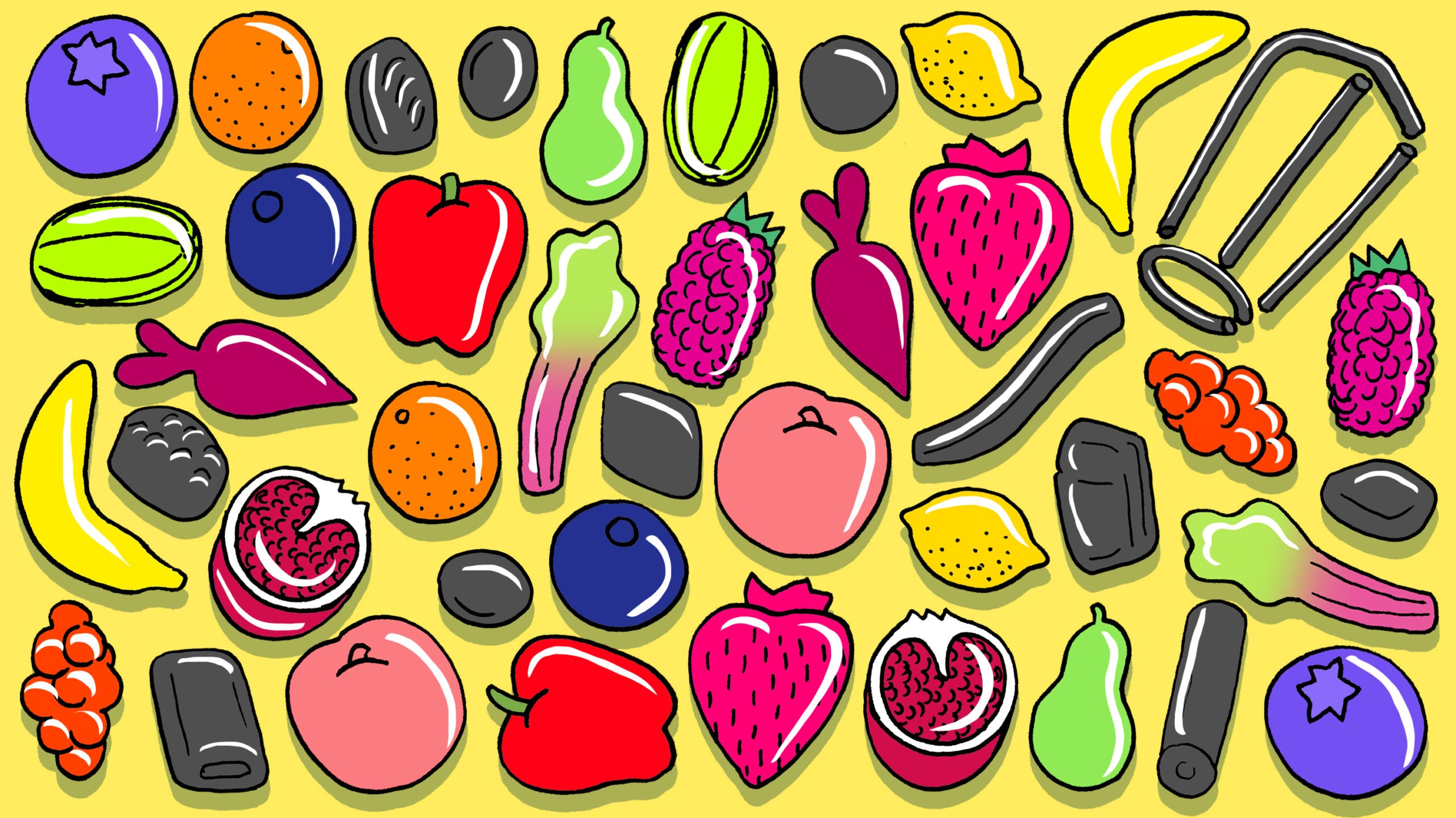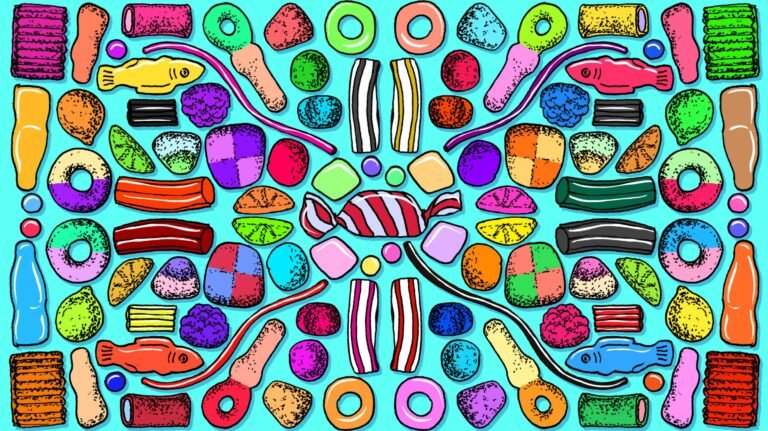It was the package that got me. About a decade ago on a trip to Sweden, I noticed an attractive candy bar with a unique black and white diamond motif in the rapper. Inside was smooth and rich milk chocolate, a jet black salmiacchi melted core and finish style salt licorice. “It’s like learning to drink coffee by adding milk and sugar,” says Nina Redforce, director of product development at Finland’s leading Candy company. I had been finding a gateway for chocolatty to licorice cultures, but never retreated. Recently I take licorice like drinking coffee: black.
I’m not alone. In the US, Scandinavian candy culture, which encompasses not only licorice, but also fruit forward gummy candies and other confectionery. And while it may seem unrelated to the new Scandinavian cuisine that has boosted the reputation of Scandinavian food worldwide, the reality is more complicated. Swedish and Finnish licorice and gummies represent an important culinary heritage rooted in local ingredients, know-how and tradition.
“Since the 1980s, Swedes have been the world leader in per capita consumption of sweets,” says Urika Torrell, a food historian and curator at the Nordic Museum in Stockholm. And for those who have spent time in Sweden, this is not a big surprise. Swedish fruit gummies are sold in a kaleidoscopic array of flavours and colors. Licorice is a seemingly endless variation and comes in several black shades. The two also frequently converge on the same treat. They are available in what feels like every grocery store, market, or gas station. The same can be said in Finland.
A few key factors have separate Swedish and Finnish fruit gummies from their global counterparts. “Our flavors are very strong,” explains Wredfors. “For fruits that grow wild in Finland or Sweden, the flavor profile is much more intense. I think it has something to do with long, light summer nights.” In candy aisles, flavors like blueberries and strawberries are added to the same type of forged fruit found in new Scandinavian dessert menus. “Every currant, gooseberries, rowanberries, rhubarb that grows in our gardens and in our forests — we put them in candies,” Wredfors says. “It directs our product development. We’re trying to match the fantastic flavors from nature.”
Another differentiator is the texture that tends to be softer than gelatin-based candies commonly found in the United States, thanks to the use of potato starch, corn starch and wheat starch. This traditional practice also affects other aspects of candymaking. “It’s very important to consider sweeteners when playing with starch,” Wredfors explains, noting that the starch mixture needs to be complemented. And in Sweden and Finland, sweeteners can come from unlikely places.
Often, sweetness comes from sugar beets grown in the European Union, rather than artificial sweeteners. Not all Scandinavian candies are this sweeter, but it is a commonly used method. “Sweden is self-sufficient in sugar beet sugar,” explains Torrell. “And it’s used in the confectionery industry.” Leo Schartz, co-owner of the popular New York-based Swedish Candy Company, uses only beet sugar in his products. “Even artificial sweeteners and cane sugar “feel differently,” he says.
Growing outside Uppsala, Sweden, Sharz also uses natural coloring from beets, along with carrots and other ingredients. He traces the rise in organic choices for high quality ingredients in candies. As a result of Swedish public health initiatives in the 1950s, the L’Argsgodis tradition, or “Saturday sweets,” encouraged parents to limit their children’s candy consumption to week. “If you only eat candy once a week,” he says, “You really want to count it.”
Finland had its own version of Saturday sweets in the form of Kalki Paipaiva, or “Candy Day.” “But,” says Jukka Anara, president of Finland’s Salt-Booth Poison Association and author of a book on Salmiacki.
The Annala Association is popular in all Nordic countries, but exists to promote the assessment of salt water, particularly related to Finland. Originally brought to the area as a cough pill in the early 20th century, licorice quickly became popular as a candy as a departing expectorant. “The line between joy and medicine has always been blurred in the history of sweets,” Torrell tells me poetically. Licorice is a typical example.
In Finland, salmiacchi is a special ingredient with a distinctive ultra-salt flavor, unlike regular licorice (Lacrit) in that it is made from ammonium chloride. It’s also somewhat divided among the Finns, Annara explains. “There are people in Finland who don’t like Salmiakki,” he says. Wredfors is one of them. As a sensory expert and a doctorate of food technology, she appreciates it on other levels. “I think it’s something in our DNA,” she says.
In the annual Salmiakkigaala of the Salty Liquarice Association, or “Salmiakki gala” (the title intended to be understood by wink), Annara and his fellow enthusiasts hand out awards to the best salty licorice products they could find, and in his words “just eat Salty Licorice” wasn’t every day in Finland? “Yes,” he tells me.
In Finland, salmiacki is not limited to soft candies that Americans recognize as “licorice.” It can be used as a syrup to pour over ice cream on pastil, tablets, or even as a flavoring for liquor. One of the most unique shapes is powder poured and licked from a hockey puck container. “On a windy day, there’s a problem,” Anala says.

Despite the possibility of a more nationalistic impulse in assessing Salmiacki, Annara and his colleagues are licorice pluralists. Their association often awards awards to Swedish products, and he is personally thrilled by the rapidly growing popularity of the genre in the US. Sharz says that on his part, fruit gummies sell far better overseas, but as a licorice enthusiast he is bullish on the outlook.
“Our salty licorice sweetness zelment,” he says.
In the candy aisle, you can see that confectionery has another important tradition: Scandinavian design. The rapper is graphic, nostalgic and frankly cool. The new luxury brand echoes minimalist trends and bright colour spare use of SANS-Serif fonts. I can’t deny that this was what attracted me first, but it’s what comes within the rapper that made me come back.
visit More Food – US.CAMPAIGN.EUROPA.EU Or follow @morethanfoodus Instagram Or more than food LinkedIn Listen to the podcast series Delicious European tales Discover amazing food and drinks from the European Union on Spotify.


